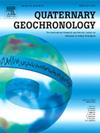Dating earthworks with luminescence: Insights from the medieval ringfort of Den Burg, Texel (the Netherlands)
IF 2.5
2区 地球科学
Q3 GEOGRAPHY, PHYSICAL
引用次数: 0
Abstract
Ancient human-made earthworks such as mounds, middens, levees, raised or terraced fields, enclosures and forts are omnipresent in many areas across the globe. They may offer rich and important information on past societies. However, harvesting such data is significantly hampered by the general lack of robust earthwork chronologies. Dating earthworks is notoriously difficult due to a variety of factors, including a scarcity of closely datable archaeological finds, the frequent absence of suitable and relevant material for radiocarbon dating, and lacking or ambiguous historical sources. Luminescence dating may provide a solution for these problems because it enables direct dating of sediment, a ubiquitous and relevant material in earthwork construction. In this paper we focus on ringforts: circular or semi-circular defensive structures surrounded by earthen banks and ditches, which originated in the first millennium CE and appear to reflect major transformations in early historical societies. We present the results of a detailed luminescence study of a ringfort underlying the modern town centre of Den Burg, on the Wadden Isle of Texel in the Netherlands. We dated samples from different sedimentary contexts (bank and ditch infills) using both quartz optically stimulated luminescence (OSL) and feldspar single-grain post-infrared infrared stimulated luminescence (pIRIR). We analyze the results in the context of age interpretations based on other proxy data (radiocarbon dates, archaeological finds, historical evidence). This yields a new, robust dating chronology that changes the biography of the ringfort. The initial construction dates between 730 and 840 CE, making Den Burg the oldest known ringfort in the Low Countries. We reflect on the best practices for luminescence dating of earthworks and on archaeological implications for other ringforts in the Netherlands and beyond.
用发光测定土方工程的年代:来自特塞尔(荷兰)登堡中世纪环堡的见解
古代人造土方工程,如土墩、丘、堤防、高地或梯田、围场和堡垒,在全球许多地区无处不在。它们可以提供关于过去社会的丰富而重要的信息。然而,由于普遍缺乏可靠的土方工程年表,收集这些数据受到严重阻碍。由于各种因素,对土方工程进行测年是出了名的困难,包括缺乏精确测年的考古发现,经常缺乏合适和相关的放射性碳测年材料,以及缺乏或模糊的历史资料。发光测年可以为这些问题提供解决方案,因为它可以直接测定沉积物的年代,而沉积物是土方施工中普遍存在的相关材料。在本文中,我们将重点放在环堡:圆形或半圆形的防御结构,周围环绕着土岸和沟渠,起源于公元第一个千年,似乎反映了早期历史社会的重大转变。我们展示了对荷兰瓦登特塞尔岛登堡现代城镇中心的环堡进行详细发光研究的结果。我们使用石英光学激发发光(OSL)和长石单粒红外后红外激发发光(pIRIR)对不同沉积背景(河岸和沟渠填充)的样品进行了年代测定。我们在基于其他代理数据(放射性碳测年、考古发现、历史证据)的年龄解释背景下分析结果。这产生了一个新的、可靠的年代编年史,改变了ringfort的历史。最初的建造时间在公元730年到840年之间,使登堡成为低地国家已知的最古老的环堡。我们反思了土方工程发光定年的最佳实践,以及对荷兰及其他地区其他环堡的考古影响。
本文章由计算机程序翻译,如有差异,请以英文原文为准。
求助全文
约1分钟内获得全文
求助全文
来源期刊

Quaternary Geochronology
地学-地球化学与地球物理
CiteScore
4.40
自引率
22.20%
发文量
130
审稿时长
20 weeks
期刊介绍:
Quaternary Geochronology is an international journal devoted to the publication of the highest-quality, peer-reviewed articles on all aspects of dating methods applicable to the Quaternary Period - the last 2.6 million years of Earth history. Reliable ages are fundamental to place changes in climates, landscapes, flora and fauna - including the evolution and ecological impact of humans - in their correct temporal sequence, and to understand the tempo and mode of geological and biological processes.
 求助内容:
求助内容: 应助结果提醒方式:
应助结果提醒方式:


